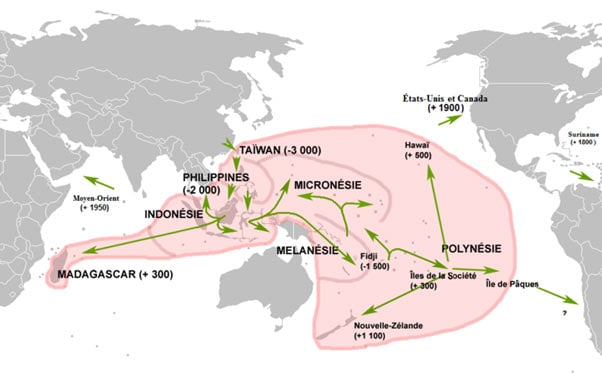
New study suggests that the Philippines is the ancestral homeland of Polynesians
Research into the origins and dispersal of Polynesian chickens has helped scientists reconstruct the early migrations of the Polynesians and the animals they carried with them. The results revealed that the Philippines is the most likely ancestral homeland of the Polynesians, whose forebears colonised the Pacific about 3,200 years ago.
Polynesian seafarers explored vast areas of the Pacific and settled nearly every inhabitable island in the Pacific Ocean well before European explorers arrived in the 16 th century. However, the ancestral relationships of people living in the widely scattered islands of the Pacific Ocean have long puzzled anthropologists. The predominant theory is that the Polynesian people are a subset of the sea-faring Austronesian people who have their origins in Taiwan, having arrived there through South China about 8000 years ago. From there it is believed that the spread out across the Pacific to Polynesia, a sub-region made up of over 1,000 islands scattered over the central and southern Pacific Ocean.

A map depicting the expansion of Austronesian languages. Image source: Wikipedia
It is thought that by roughly 1400 BC, the ‘Lapita People’, so-named after their pottery tradition, appeared in the Bismark Archipelago of northwest Melanesia. This culture is seen as having adapted and evolved through time and space since its emergence "Out of Taiwan". Within a mere three or four centuries between about 1300 and 900 BC, the Lapita archaeological culture spread 6,000 km until it reached as far as Fiji, Tonga, and Samoa.
However, the belief that the Lapita people are related to the Polynesians has long been debated, and direct links between Lapita and mainland Southeast Asia are still missing, due to a lack of data in Indonesia and Malaysia.

The face of Mana, a Lapita woman whose face was reconstructed using a model of her skull which was excavated from an early human settlement at Naitabale in Fiji. Photo source.
In the latest study published in the American journal Proceedings of the National Academy of Sciences, an international team of researchers led by Alan Cooper, director of the Australian Centre for Ancient DNA (ACAD), at the University of Adelaide used ancient DNA to study the origins and dispersal of ancestral Polynesian chickens. They found that Polynesian chickens had their genetic roots in the Philippines, making that region a candidate for the homeland of the mysterious Lapita people who transported the domesticated birds to the Pacific islands.
"We don't find this [genetic] signature anywhere else in the world except in the Philippines and neighbouring areas," said Professor Cooper.
However, he also stressed that the Philippines could merely have been a stopover point for the ancient mariners. Further research is now been conducted on modern chickens in Southeast Asia to see where the genetic trail leads.
Featured image: An illustration of ancient Polynesians. Photo source.
















Comments
Chickens? Really? I'll have to have something else to go on.
malisa wright
So, we are the possible true discoverer of the New World.
Native Americas came from north east asia hence why they share the same dna as them. There is no cultural and linguistic connections that the Polynesians share with the Native Americas. If you look at the native Americas they are short brown skinny with orientatal eyes. Sweet Potatoes came from Africa and it was said that it was through trade as to why it got there. Polynesian settlement was not stayed in South America as they probably came there and returned back to Polynesia as the Native Americas were very adamant when they saw new people being that Polynesians were bigger too. Polynesians, Micronesians and Melasians share cultural and linguistic similarities between South East Asian Islands that's evident as there are some similar words. Native Americas do not share any cultural and linguistic similarities with Polynesia Micronesia and Melanesia. Why else would a chicken end up in Oceania that can't be found anywhere else. There are some Filipinos who look Polynesians but it's just they're smaller build as Polynesians ate potatoes and coconut which what makes a person big and through time that's why Polynesians are big and mostly fat. Times have changed in Polynesia where there isn't no seafarers and less work to do. Polynesians can thank their Austronesian ancestors like Aboriginal Taiwan Philippines and Indonesia as they were excellent seafarers going from island to island in South East Asian Islands.
DNA already proved how people did not disperse from the Philippines, based on both Y-DNA and mtDNA that exists in East Asia and specifically in Polynesia. Everyone else commented about how the chicken came from the Philippines as not being evidence which is true. The said could be same about the sweet potato whereby Polynesians had contact with the Americas, but it does not mean that the Americas colonized Polynesia.
We live in Hawaii, my fathers ancestry arrived here from Philippines. My father is 100% Filipino but his family claims Filipino, Chinese, Spanish. However after doing an ancestry DNA sample as well, his ethnicity was as follows 62% Asia East, 4% Asia South, and 32% Polynesia. This article is strikingly supportive to my father's ethnicity.
Pages